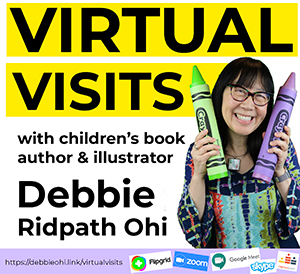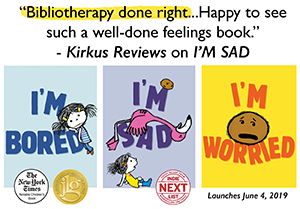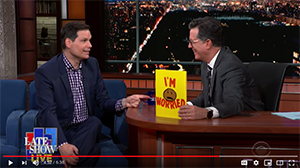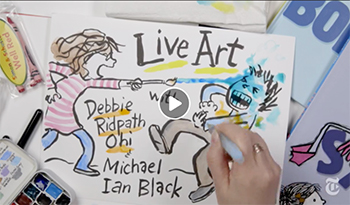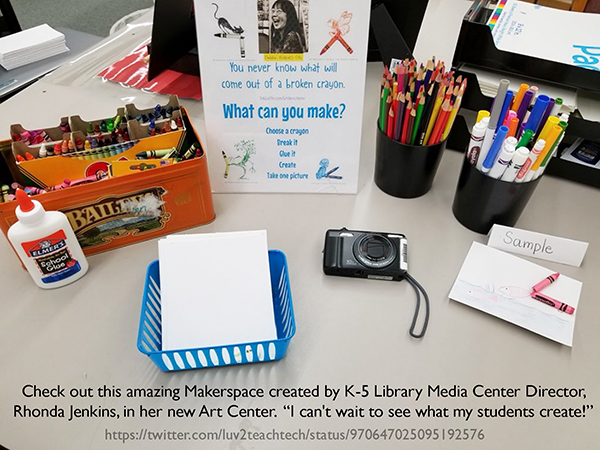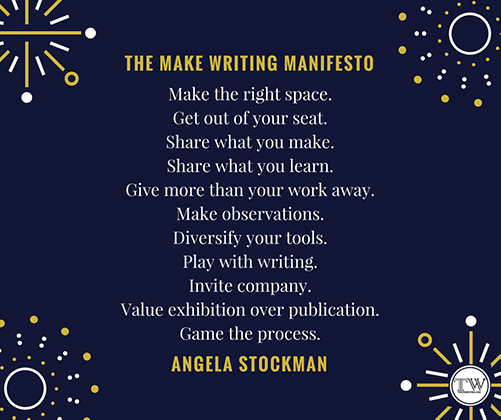Back to For The Love Of Reading
MAKERSPACE ACTIVITIES THAT ENCOURAGE WRITING, READING AND CREATIVITY
(Last updated July 23, 2018)
PRINT-READY PDFS
Handout from Jess Keating's and Debbie Ridpath Ohi's Makerspace session at nErDcampmi 2018 (4.8 MB) - Direct download
Example of ideas for Makerspace activities for any book (including nonfiction), by Jess Keating
Activity: "You never know what will come out of a broken crayon" handout - Direct download
WHAT IS A MAKERSPACE?
Makerspaces provide a variety of materials and supportive tools for hands-on 'making.' Students can get hands-on experience working with concepts they are learning.
"The term generally refers to using a wide variety of hands-on activities (such as building, computer programming, and sewing) to support academic learning and the development of a mindset that values playfulness and experimentation, growth and iteration, and collaboration and community. " (Source: The Maker Movement In K-12 Education" in Edweek.org)
Other terms used when discussing makerspaces include "tinkering" and "hackerspace".
Makerspaces were popular for adults but in recently years, makespaces for young people have become more popular.
SOME BENEFITS OF MAKERSPACES:
- Encourage student engagement and reflection.
- Provide opportunities for divergent thinking.
- Hands-on exploration.
- Provides a connection between lessons and the real world.
- Encourage independent learning.
- Inspires curiosity and further investigation.
- Encourages deeper thinking, innovation (instead of rote memory).
- Failure is a lesson, not an end.
- Collaboration and community building.
- Break the habit of wastefulness.
KEY POINTS:
A child who claims to hate writing may be a maker, and making could become his or gateway into writing. (Source: Intention: Critical Creativity In The Classroom by Amy Burvall & Dan Ryder)
On the other hand, not all writers are makers. Some students might just want to sit and write.
Surveying the students to find out what they're interested in, their favorite media.
Every makerspace is going to be different.
Experimentation, open-ended or messy play, an emphasis on creativity and process rather than the final product.
"Kids who hate to write often work best in spaces where writing is made....These writers need an environment thta encourages them to share and celebrate risk-taking so that they may uncover one critical truth: The lessons they learn from their struggles are no less valuable than those they learn from their successes." (Source: Make Writing: 5 Teaching Strategies That Turn Writer's Workshop Into A Maker Space - by Angela Stockman)
"When we make writing, we tear things down, break them apart, build, test, reconstruct as we go." (Source: Intention: Critical Creativity In The Classroom by Amy Burvall & Dan Ryder)
The real meaning students get from making is the process, NOT the product. Example: Writing a reflection about the writing process is difficult BUT when students write a reflection after making, reflecting is easier because of the deep thinking that occurs during the process of making. (Source: ColleenGraves.org)
Make time for purposeful reflection, exhibiting/sharing the work. In her book Make Writing: 5 Teaching Strategies That Turn Writer's Workshop Into A Maker Space, Angela Stockman suggests always leaving time for informal exhibition at the end of every session. Suggested prompts include questions like: "What did you expect to learn today? What did you actually learn? How do you feel about this?" "When were you frustrated today, and how did you overcome this frustration?" "What did you learn from others what was helpful today?"
MAKERSPACE ENVIRONMENT TIPS AND STRATEGIES:
- Create a poster with guidelines for your Makerspace, posted where everyone can see. Some examples: "Plan. Perserver. Put Away." Here is the "The Make Writing Manifesto" by Angela Stockman:
- Invite students to build before they write or write about the things they are currently building. (Source: Make Writing: 5 Teaching Strategies That Turn Writer's Workshop Into A Maker Space - by Angela Stockman)
- Allow students to work together and work alone at the same time (see "Peer Partnerships" description in this article about Angela Stockman's studio).
- Connect students to authentic audiences (writing challenges like National Novel Writing Month for students, writing a letter to an author, illustrator or newspaper/magazine editor etc.) (Source: TeachWriting.org, quoting Angela Stockman)
- Let sudents share process as well as results. (Source: TeachWriting.org, quoting Angela Stockman)
- Ask individual students leading questions, let students talk out their story plans. (see "Cues and Creativity" in this article about Angela Stockman's studio)
- Find the intersections between students' personal interests and your curriculum. "Students will be more likely to develop academic pursuits when classroom content connects to their passions." Another piece of advice: "To support young makers, teachers should regularly engage students in making, sharing, collaborating and reflecting." (Source: "ReMaking Education: Designing Classroom Makerspaces For Transformative Learning")
MAKERSPACE AREAS:
- Blank wall space for post-it notes, etc.
- Blank table space for post-it notes, etc.
- Poster paper, styrofoam board, bristol board.
- Idea from Angela Stockman: paint tabletops with chalk paint.
MAKERSPACE SUPPLIES:
- Focus on how it works, not how it looks.
- Post-it notes, index cards, cut-up paper for notes.
- Upcycling: using discarded materials to make something new that is even better than the original. Some teachers, for example, have students work on recycled book crafts - using books with broken spines or book pages to make projects.
- Save money by stocking your Makerspace with items that are typically found around the house or school e.g. boxes of different sizes, paper towel and toilet paper tubes, egg cartons, different kinds of tape, liquid and stick glue. Ask donations from parents for other items: e.g. cereal boxes, wire, yarn, toothpicks, cups, recycled plastic containers etc.
MAKERSPACE ACTIVITY IDEAS:
Also see Debbie's Pinterest board: Makerspaces That Encourage Writing & Reading.
IDEA GENERATION:
- Photo collage inspiration board before jumping into writing.
- Story bags: Label a cloth bag "Once Upon A Time" and inside, have story prompts (could be pictures of animals/places/things for younger kids, text for older?). Story begins "Once upon a time" and students take turns drawing items, add to the story (verbally or written). Story Starters (also bags): Find simple paper bags, fill with items. Label each with a number, invite students to draw a number, then tell/write a story using items as prompts. Optional collaborative writing exercise.
LANGUAGE:
- Play with small changes to words that in turn create significant impact -> create works that embed word remixes. (Source: Intention: Critical Creativity In the Classroom by Amy Burvall and Dan Ryder)
- On stackable bricks or Lego blocks, write words and phrases (or use sticky notes or repositionable labels).
STORY:
- Arrange and rearrange plot points.
- Come up with possible twist endings.
CHARACTER:
- List of character traits.
- Draw/paint/sculpt a character.
- Create a character using found object art, then write about that character.
SETTING:
- Design (via drawing or creating from physical objects) the building where a story takes place.
POETRY:
- Create a found poem by taking words and phrases from other sources and reframing them as poetry by making changes in spacing and lines, adding and deleting text....thus imparting new meaning.
- Create blackout poetry with discarded books.
BIOLOGY:
- Invent and describe an imaginary creature. One suggestion: do a mash-up of classifications, then write about the new creature. Exercise could be combined with a study of taxonomy.
OTHER TYPES OF WRITING:
- Music that could inspire writing song lyrics.
- Lego pieces labelled with words and phrases, can be used to write.
ONLINE RESOURCES:
My list of educators & librarians on Twitter who post about Makerspaces
Curious about classroom Makerspaces? Here's how to get started. - by Angela Watson.
Welcome to my Makerspace - by Brooke Brown in Teach Outside The Box
Make Writing - Created by Angela Stockman, author of MAKE WRITING: 5 Teaching Strategies That Turn Writer's Workshop Into A Maker Space. Also see this GettingSmart.com article about Angela's studio in action.
Seven Surprising Benefits Of Maker Spaces - by Carrie Barron and Alton Barron, School Library Journal.
10 Reasons To Create Makerspaces In Your School - by Matthew Lynch, The Tech Edvocate.
Makerspaces in Education & Literacy - by Danielle Marie Kowalewicz
What a Makerspace can mean for the Writing Classroom - Takeaways from NWP Annual Meeting - by Colleen Graves.
Makerspaces: How Parents Support Young Children's Learning
RELATED BOOKS:
Make Writing: 5 Teaching Strategies ThAT Turn Writer's Workshop Into A Maker Space - by Angela Stockman
Intention: Critical Creativity In the Classroom - by Amy Burvall and Dan Ryder

